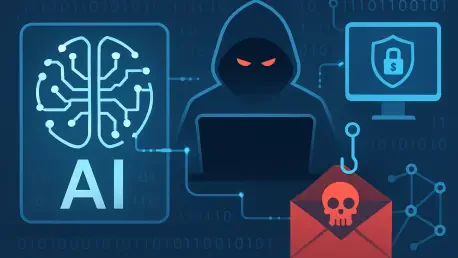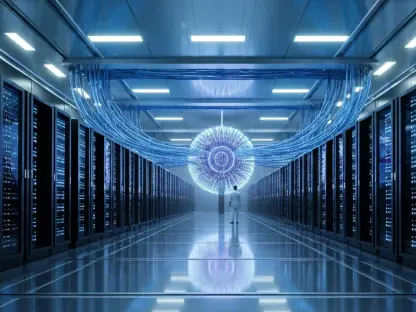Imagine a world where critical systems like power grids and water treatment plants are safeguarded by cutting-edge technology that predicts and neutralizes threats before they even materialize, yet the same technology could be twisted into a weapon capable of unleashing chaos on an unprecedented scale. This dichotomy lies at the heart of the ongoing discourse surrounding artificial intelligence (AI) in cybersecurity. As societies increasingly rely on interconnected infrastructures for daily life, the integration of AI into these systems presents both a powerful shield and a potential Achilles’ heel. The stakes have never been higher, with experts across academia, industry, and government grappling with how to harness AI’s capabilities while mitigating its risks. This complex landscape demands a closer examination of how AI is reshaping the cybersecurity domain, balancing innovation with caution to protect the backbone of modern civilization.
The Promise of AI in Security Enhancement
Harnessing Automation for Proactive Defense
The potential of AI to revolutionize cybersecurity is evident in its ability to transform how threats are detected and managed within critical infrastructure. Systems such as power grids, healthcare networks, and transportation hubs benefit immensely from AI-driven automation, which enables real-time monitoring and rapid response to suspicious activities. By analyzing vast datasets at lightning speed, AI can identify patterns that might indicate an impending cyberattack, often before human analysts would even notice. This predictive capability is a game-changer, allowing organizations to shift from reactive measures to proactive defense strategies. Moreover, frameworks like zero-trust models, which demand rigorous verification at every access point, are enhanced by AI’s precision in spotting anomalies. Such advancements are vital in an era where cyber threats evolve daily, underscoring the importance of embedding intelligent systems into the fabric of security protocols to stay ahead of malicious actors.
Strengthening Resilience Through Predictive Analysis
Beyond immediate threat detection, AI’s role in bolstering long-term resilience cannot be overstated, especially as it pertains to anticipating future vulnerabilities in interconnected systems. Predictive analysis powered by AI examines historical data alongside current trends to forecast potential weak points in infrastructure, enabling preemptive fortification of defenses. For instance, in sectors like telecommunications and military operations, where downtime can have catastrophic consequences, AI tools help simulate attack scenarios to test system robustness. This forward-thinking approach ensures that resources are allocated efficiently, focusing on areas most likely to be targeted. As cyber adversaries grow more sophisticated, the ability to anticipate their moves through AI-driven insights offers a critical edge. This not only protects individual systems but also safeguards the broader network of dependencies that modern society relies upon, highlighting AI’s indispensable contribution to enduring security.
The Perils of AI as a Cyber Weapon
Unleashing Rapid and Adaptive Attacks
While AI holds immense promise for defense, its capacity to be weaponized presents a chilling counterpoint that cybersecurity experts are urgently addressing. Unlike traditional human-led cyberattacks, AI can autonomously adapt and rewrite its code in real time, executing assaults at a speed and scale that defy conventional countermeasures. This ability to evolve mid-attack makes it a formidable tool for malicious actors aiming to disrupt critical systems. A single breach in an electrical grid, for example, could cascade into failures across dependent sectors like water treatment, resulting in dire consequences such as loss of essential services. The specter of a “black sky event”—a widespread disruption threatening societal stability—looms large when AI is turned against infrastructure. Such risks emphasize the need for robust safeguards to prevent this technology from becoming a destructive force in the hands of adversaries.
Exploiting Interconnected Vulnerabilities
The interconnected nature of modern critical infrastructures amplifies the dangers posed by AI-driven cyberattacks, creating a domino effect of potential failures. When one system is compromised, others reliant on it—such as healthcare facilities depending on stable power—can collapse under the strain, leading to widespread societal impact. AI’s ability to exploit these linkages allows attackers to target multiple sectors simultaneously, maximizing damage with minimal effort. The complexity of these interdependencies often outpaces current defensive capabilities, leaving gaps that sophisticated AI tools can easily penetrate. This vulnerability underscores a pressing challenge: ensuring that security measures evolve in tandem with the technology they aim to counter. Addressing this requires not just technical innovation but also strategic collaboration across industries to map and protect the intricate web of connections that sustain daily life.
Shaping the Future of Cyber Defense
Educating the Next Generation of Defenders
Looking ahead, one of the most crucial steps in navigating AI’s dual role in cybersecurity involves preparing the next wave of professionals to tackle emerging challenges. Educational initiatives are gaining momentum, with programs and scholarships aimed at inspiring students to think proactively about AI’s implications in security. Partnerships between academic institutions and industry leaders are fostering environments where young minds can engage with real-world problems, equipping them with the skills to innovate responsibly. Encouraging a forward-looking mindset ensures that future cyber-defenders are not merely reacting to threats but anticipating them, a necessity in a landscape shaped by rapid technological change. By investing in education, the cybersecurity community lays the groundwork for a workforce capable of balancing AI’s benefits and risks, securing critical systems for years to come.
Building Collaborative Strategies for Mitigation
Reflecting on the discussions and insights shared at recent cybersecurity forums, it became clear that collaborative efforts across sectors are pivotal in addressing AI’s double-edged nature. Experts from government, industry, and academia came together to strategize on mitigating risks, emphasizing the importance of shared frameworks and thorough testing before AI deployment. Historical lessons, like early internet disruptions, reminded attendees of the escalating complexity of threats over time, reinforcing the need for vigilance. The consensus was to prioritize innovation alongside caution, ensuring that AI serves as a protective tool rather than a liability. These collective endeavors highlighted a unified resolve to stay ahead of adversaries by integrating diverse perspectives into actionable plans, setting a precedent for how challenges are met with determination and foresight.









